2023年中考英语句子成分、结构 课件(共33张PPT)
文档属性
| 名称 | 2023年中考英语句子成分、结构 课件(共33张PPT) | 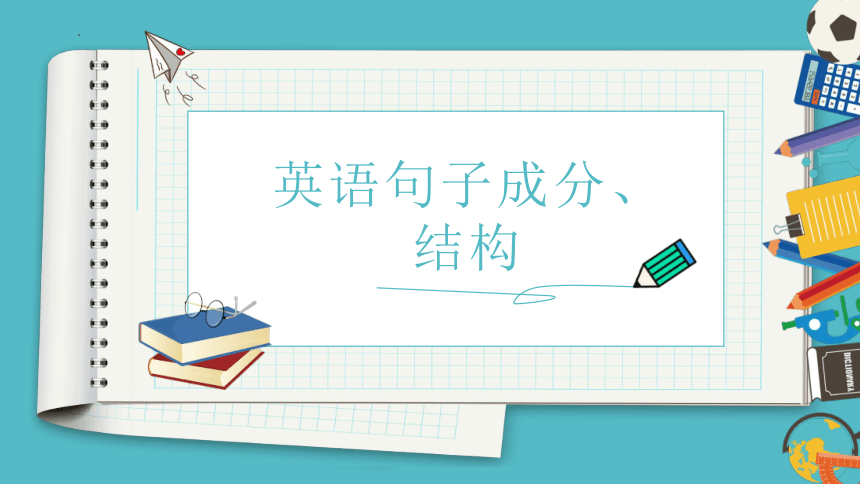 | |
| 格式 | zip | ||
| 文件大小 | 556.2KB | ||
| 资源类型 | 教案 | ||
| 版本资源 | 人教新目标(Go for it)版 | ||
| 科目 | 英语 | ||
| 更新时间 | 2022-08-08 10:20:55 | ||
图片预览

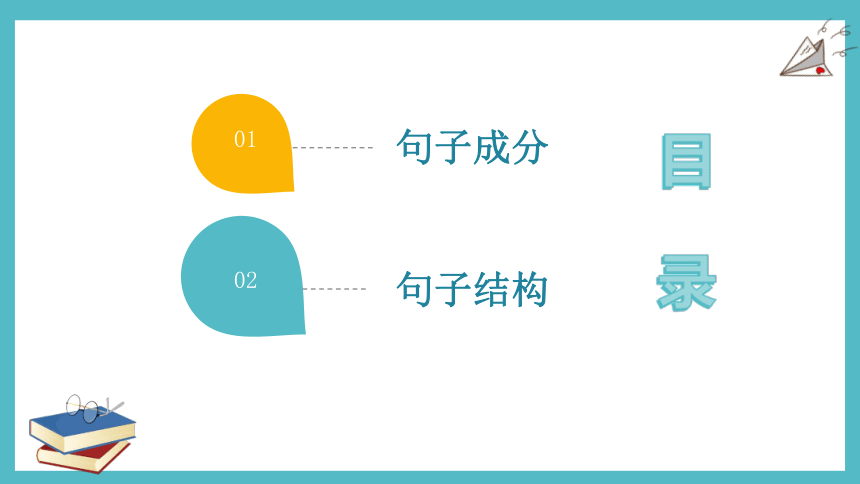
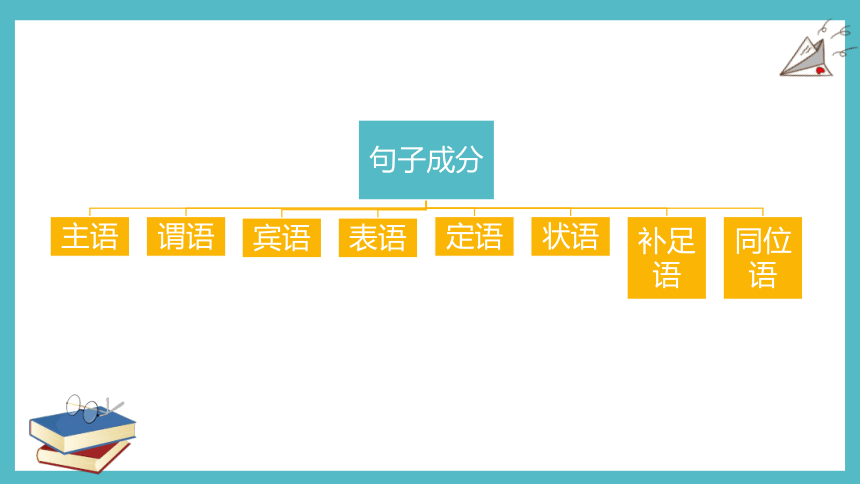
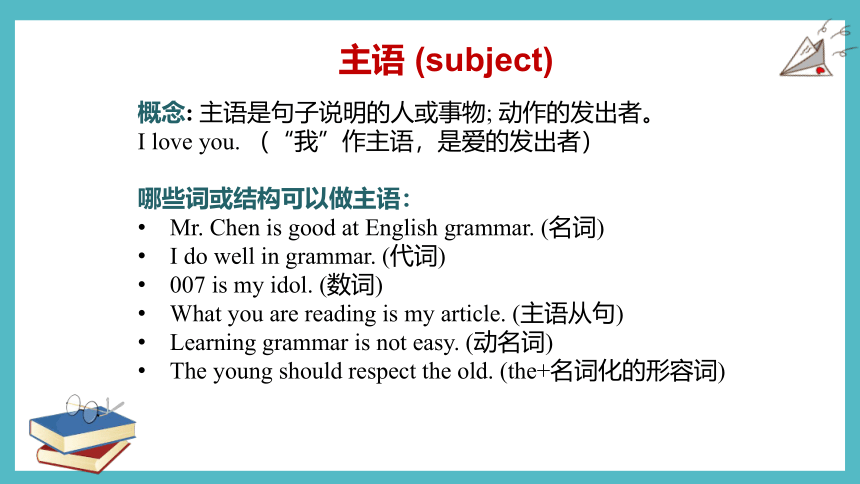
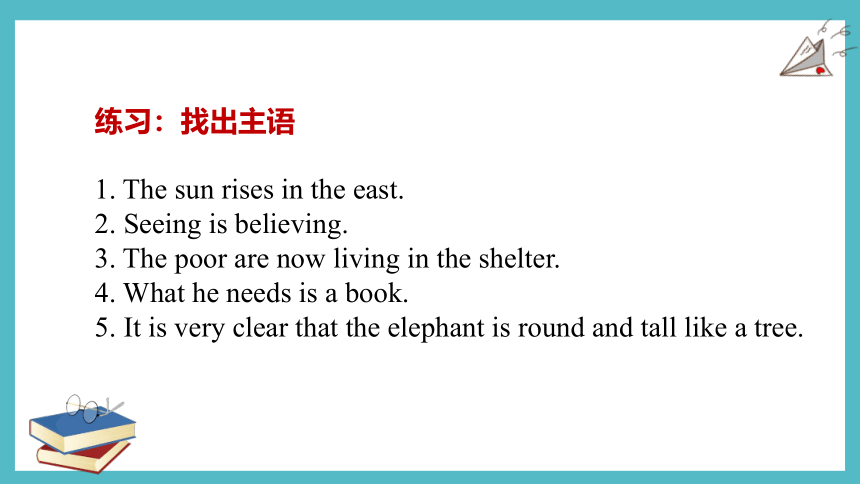
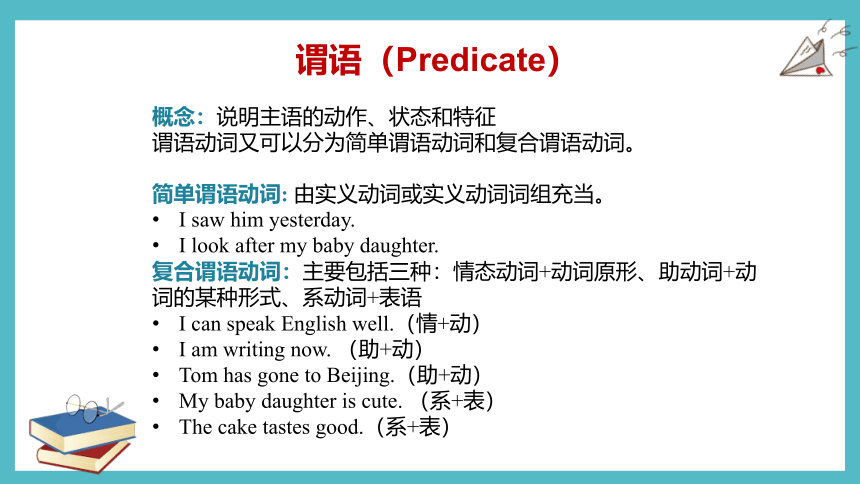
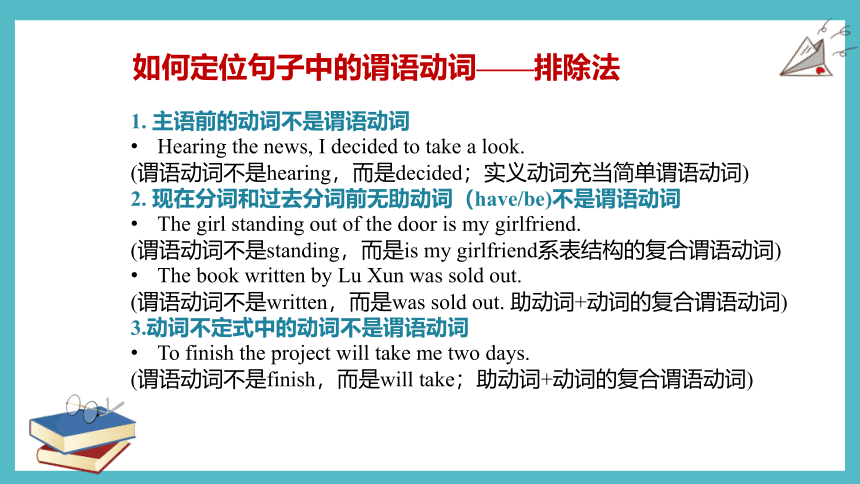
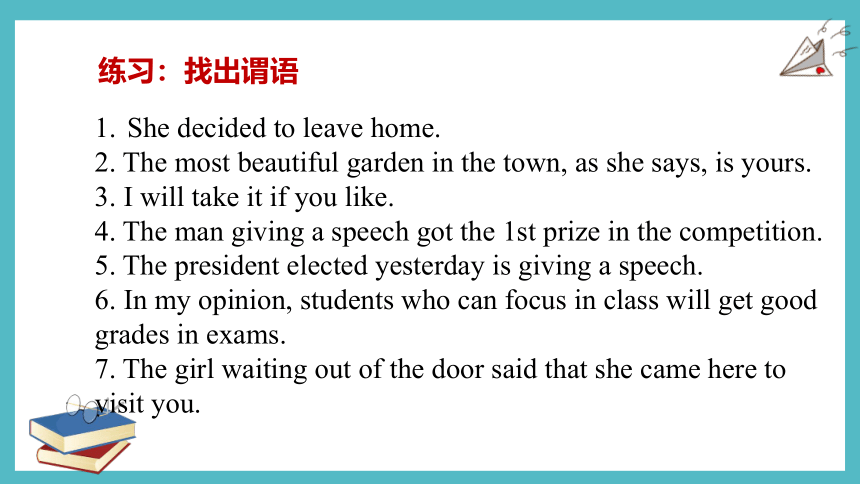
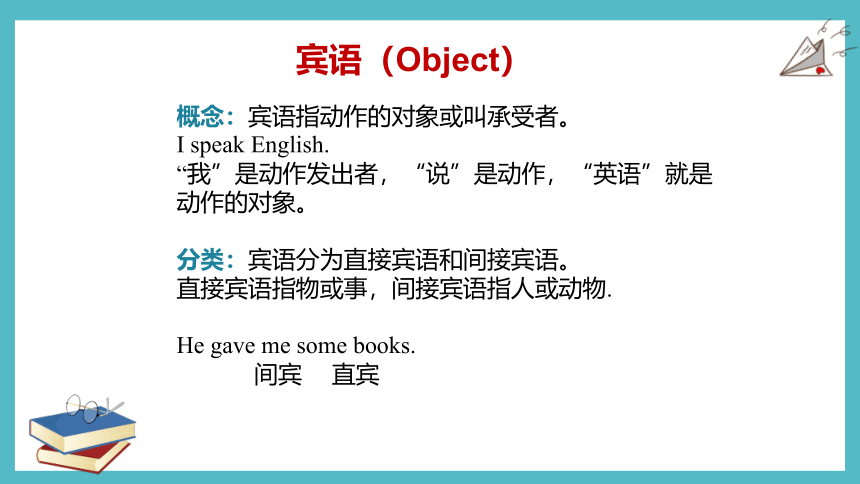
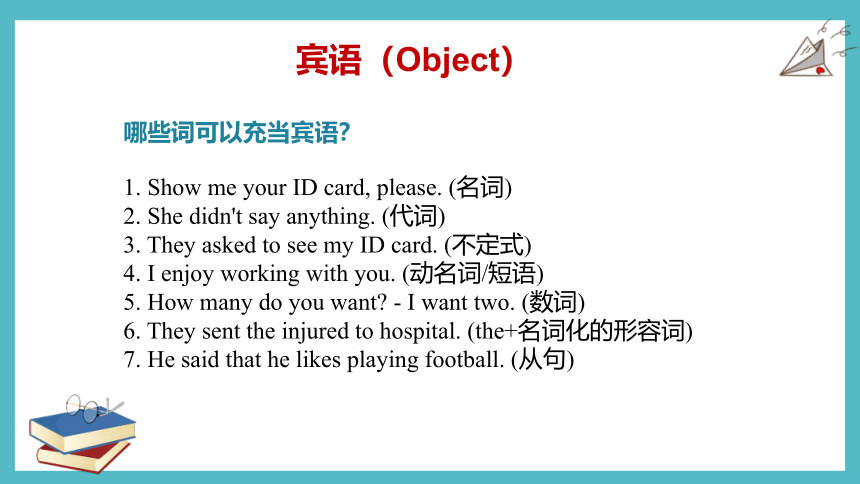
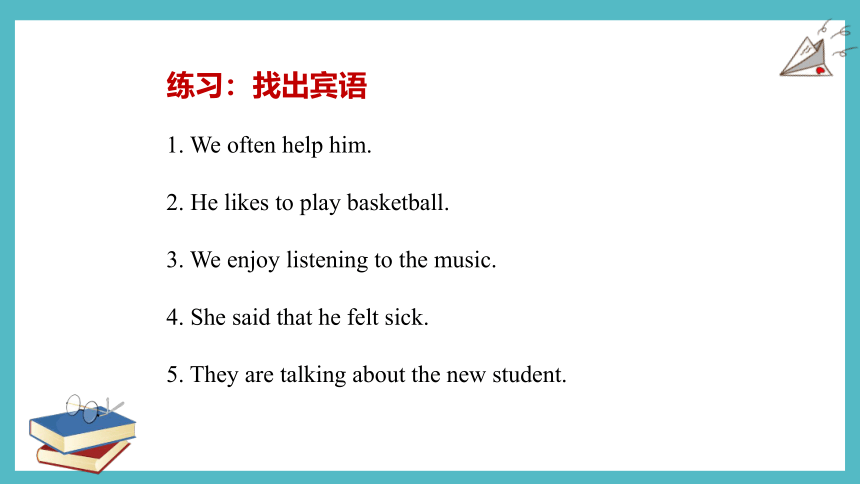
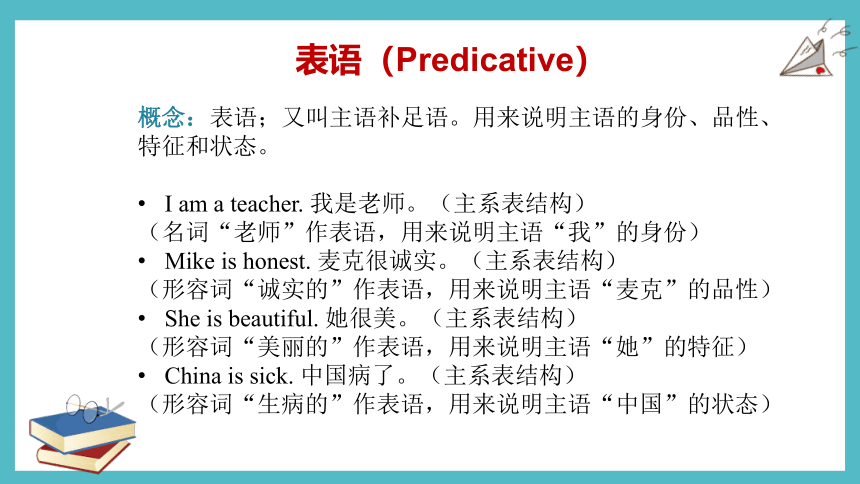
文档简介
(共33张PPT)
英语句子成分、结构
01
02
04
句子成分
句子结构
目 录
主语 (subject)
概念: 主语是句子说明的人或事物; 动作的发出者。
I love you. (“我”作主语,是爱的发出者)
哪些词或结构可以做主语:
Mr. Chen is good at English grammar. (名词)
I do well in grammar. (代词)
007 is my idol. (数词)
What you are reading is my article. (主语从句)
Learning grammar is not easy. (动名词)
The young should respect the old. (the+名词化的形容词)
练习:找出主语
1. The sun rises in the east.
2. Seeing is believing.
3. The poor are now living in the shelter.
4. What he needs is a book.
5. It is very clear that the elephant is round and tall like a tree.
谓语(Predicate)
概念:说明主语的动作、状态和特征
谓语动词又可以分为简单谓语动词和复合谓语动词。
简单谓语动词: 由实义动词或实义动词词组充当。
I saw him yesterday.
I look after my baby daughter.
复合谓语动词:主要包括三种:情态动词+动词原形、助动词+动词的某种形式、系动词+表语
I can speak English well.(情+动)
I am writing now. (助+动)
Tom has gone to Beijing.(助+动)
My baby daughter is cute. (系+表)
The cake tastes good.(系+表)
1. 主语前的动词不是谓语动词
Hearing the news, I decided to take a look.
(谓语动词不是hearing,而是decided;实义动词充当简单谓语动词)
2. 现在分词和过去分词前无助动词(have/be)不是谓语动词
The girl standing out of the door is my girlfriend.
(谓语动词不是standing,而是is my girlfriend系表结构的复合谓语动词)
The book written by Lu Xun was sold out.
(谓语动词不是written,而是was sold out. 助动词+动词的复合谓语动词)
3.动词不定式中的动词不是谓语动词
To finish the project will take me two days.
(谓语动词不是finish,而是will take;助动词+动词的复合谓语动词)
如何定位句子中的谓语动词——排除法
She decided to leave home.
2. The most beautiful garden in the town, as she says, is yours.
3. I will take it if you like.
4. The man giving a speech got the 1st prize in the competition.
5. The president elected yesterday is giving a speech.
6. In my opinion, students who can focus in class will get good grades in exams.
7. The girl waiting out of the door said that she came here to visit you.
练习:找出谓语
宾语(Object)
概念:宾语指动作的对象或叫承受者。
I speak English.
“我”是动作发出者,“说”是动作,“英语”就是动作的对象。
分类:宾语分为直接宾语和间接宾语。
直接宾语指物或事,间接宾语指人或动物.
He gave me some books.
间宾 直宾
宾语(Object)
哪些词可以充当宾语?
1. Show me your ID card, please. (名词)
2. She didn't say anything. (代词)
3. They asked to see my ID card. (不定式)
4. I enjoy working with you. (动名词/短语)
5. How many do you want - I want two. (数词)
6. They sent the injured to hospital. (the+名词化的形容词)
7. He said that he likes playing football. (从句)
练习:找出宾语
1. We often help him.
2. He likes to play basketball.
3. We enjoy listening to the music.
4. She said that he felt sick.
5. They are talking about the new student.
表语(Predicative)
概念:表语;又叫主语补足语。用来说明主语的身份、品性、特征和状态。
I am a teacher. 我是老师。(主系表结构)
(名词“老师”作表语,用来说明主语“我”的身份)
Mike is honest. 麦克很诚实。(主系表结构)
(形容词“诚实的”作表语,用来说明主语“麦克”的品性)
She is beautiful. 她很美。(主系表结构)
(形容词“美丽的”作表语,用来说明主语“她”的特征)
China is sick. 中国病了。(主系表结构)
(形容词“生病的”作表语,用来说明主语“中国”的状态)
表语(Predicative)
哪些词可以充当表语?
Our English teacher is an American.(名词)
Is it yours (代词)
The weather has turned cold.(形容词)
The speech is exciting.(分词)
Three times seven is twenty one (数词)
His dream is to teach English.(不定式)
His hobby is playing football.(动名词)
The machine must be out of order.(介词短语)
Time is up; The class is over.(副词)
The truth is that he has never been abroad.(表语从句)
练习:找出表语
1.The epidemic situation is over.
2. They are on the playground.
3.Time is precious.
4. It gets cold.
5. It sounds interesting.
宾补(Object Complement)
概念:宾补,全称宾语补足语,顾名思义,对宾语进行补充。说明宾语的身份、动作、特征和状态,以使句子语义表达完整。
We elected John monitor. 我们选举约翰当班长。(主谓宾宾补结构)
(名词“班长”作宾补,用来补充说明宾语“约翰”的身份)
She saw me crying. 她看到了我在哭。(主谓宾宾补结构)
(现在分词“哭”作宾补,用来补充说明宾语“我”的动作)
He found the book readable. 他发现这本书通俗易懂。(主谓宾宾补结构)
(形容词“通俗易懂的”作宾补,用来补充说明宾语“这本书”的特征)
You make me happy. 你让我开心。(主谓宾宾补结构)
(形容词“开心的”作宾补,用来补充说明宾语“我”的状态)
宾补(Object Complement)
哪些词可以充当宾补:
1. We call him Iron Man. (名词)
2. The doctor told me to do more exercise. (不定式短语)
3. I made her sad. (形容词)
4. I have my hair cut. (过去分词表被动)
5. They saw a bird flying in the sky. (现在分词)
定语(Attribute)
概念:修饰或限定名词或代词的句子成分;通常形容词作定语的占比最大。
English is a useful tool. 英语是个有用的工具。(主系表结构)
(形容词“有用的”作定语,用来修饰表语“工具”。)
I have two computers. 我有两台电脑。(主谓宾结构)
(数词“2”作定语,用来限定宾语“电脑”的数量)
从以上两个例句可以看出修饰和限定不一样,不能混为一谈。
定语的分类:定语分为前置定语和后置定语。
He is our friend.(前置定语放在名词前面)
The man over there is my old friend.(后置定语放在名词后面)
哪些词可以充当定语?
Zhong Nanshan is a real hero. (形容词)
He is our friend.(代词)
I have ten brothers.(数词)
Mr. Chen is a chemistry teacher.(名词)
The man over there is my old friend.(副词短语)
The woman in red is my wife.(介词短语)
The boys playing football are in Class 2.(现在分词短语)
The trees planted last year are growing well now.(过去分词短语)
I have an idea to do it well.(不定式短语)
Jerry afraid of Tom is smart. (形容词短语)
You should do everything that I do.(定语从句)
状语(Adverbial)
概念:状语是说明动作或状态特征的成分。
副词这类词在句子中所充当的句子成分其实就是状语。
副词都有哪些功能:
He works hard. 他工作努力。
(副词“努力地”作“状语”,用来修饰“动词”“工作”)
He works very hard. 他工作非常努力。
(副词“非常”作状语,用来修饰“副词”“努力地”的程度)
He is very smart. 他非常聪明。
(副词“非常”作状语,用来修饰“形容词”“聪明的”的程度)
Unluckily, he didn't pass the exam. 很不幸,他没通过考试。
(副词“不幸地”作状语,用来修饰“整个句子”)
副词/状语的功能有四个:修饰动词、形容词、其他副词、句子。
状语(Adverbial)
分类:按照用途作用常见的状语可分为11种:
1. 时间状语: I watched TV last night.
2. 地点状语: They are playing football on the playground.
3. 原因状语: He was sent to prison for robbery.
4. 结果状语: The stone is too heavy for me to lift.
5. 条件状语: I can't live without you, my baby!
6. 让步状语: With all his efforts, he lost the game.
7. 目的状语: I joined you to learn grammar.
8. 方式状语: I study grammar via the internet.
9. 程度状语: I like grammar very much.
10. 伴随状语: She said goodbye with tears in her eyes.
11. 方面状语: I do well in English grammar. Follow us now!
状语(Adverbial)
哪些词/结构可以充当状语?
They are playing football on the playground. (介词短语)
Eve works hard. (副词)
The students followed Uncle Wang to see the other machine. (不定式短语)
His parents died, leaving him an orphan. (现在分词短语)
Moved by the movie, the audience began to cry.(过去分词短语)
He began to learn English when he was eleven. (状语从句)
状语的位置:
状语的位置灵活多变,不同的状语分别可以放到句首、句中和句末。
同位语(Apposition)
概念:同位语,解释或补充说明前面名词/代词的情况;是对前面名/代词内容的具体化展现。
同位语,顾名思义,和前面名词/代词在语法上处于相同的地位/层级。
I am your English teacher Mr. Chen.
我是你们英语老师陈老师。
(名词“陈老师”作“同位语”,用来补充“名词词组”“你们英语老师”的名字)
同位语(Apposition)
分类:根据同位语和前面同位名词/代词的关系可以分为两种。
完整意义:
I am your English teacher Mr. Chen.
(同位语“陈老师”和前面同位的名词词组“你们英语老师”是相等的关系;即表达了完整意义。单个名词作同位语和前面名词/代词用不用逗号隔开都行。)
Mr. Chen, your English teacher, is interested in English grammar.
(同位语“你们英语老师”和前面同位的陈老师是相等的关系;即表达了完整意义。词组作同位语通常和前面名词/代词用逗号隔开)
部分意义:
I am interested in English, especially grammar.
(同位语“语法”和前面同位的名词“英语”是部分和整体的关系;即表达了部分意义。)
同位语(Apposition)
哪些词/结构可以充当同位语?
I am your English teacher Mr. Chen. (名词)
We all love you.(代词)
The news that our team has won the match is true. (从句)
同位语的位置:
同位语的位置通常比较固定,紧跟在要解释说明或补充的名词/代词后面;同位语从句有时候会出现和前面同位名词/代词隔开的情况。
练 习:找出同位语
1. We young people should respect the old.
2. He himself will do the experiment.
3. He is the oldest among them four.
4. He told me the news that our team won the game.
Mr. Chen is our teacher and he asks us students to learn English every day.
分析下面这句话句子成分:
Mr. Chen is our teacher and he asks us students to learn English every day.
这是个含有两个简单句的并列句。句式结构比较简单、意思也很明了。
and前面的简单句Mr. Chen is our teacher. 的结构是:主系表
即:主语Mr. Chen+系动词is(+定语our)+表语teacher
and后面的简单句he asks us students to learn English every day.的结构是:主谓(谓语动词)宾宾补
即:主语he+谓语动词asks+宾语us(+同位语students)+宾补to learn English(+状语every day)
简单句1里面包含的句子成分有:主语、定语和表语
简单句2里面包含的句子成分有:主语、谓语动词、宾语、同位语、宾补和状语
练 习:分析句子结构和成分
1. I am a student.
2. He is happy today.
3. You made me happy.
4. He likes pop music.
5. He gave me some advice.
6. The food is good.
7. she didn't come here.
8. he went away.
9. we need to go.
10. We know him very well.
S+V (主+谓)
S+V+P (主+系+表)
S+V+O (主+谓+宾)
S+V+IO+DO(主+谓+间宾+直宾)
S+V+DO+OC (主+谓+宾+宾补)
简单句五大句型
主 + 谓(S+V) 名词/代词/不定式/动名词 + 动词 谓语动词可以表达完整的意思,这类动词为不及物动词(vi) So I do, master.
Little Robin chirped and sang.
主+系+表(S+V+P) 主语 +系动词 +表语 表语说明主语的状态和性质,可以是名词,形容词,副词,短语等。 I'm always alone.
The storms grow stronger.
He was so small.
主+谓+宾(S+V+O) 主语+谓语+宾语 谓语一般为及物动词(vt.),后面必须要跟宾语才能表达完整的意思。宾语是谓语动词动作的承受者。 I met a man with seven wives.
We'll have a pudding in half an hour.
主+谓+间宾+直宾 (S+V+IO+O) 这种句型,谓语动词必须要跟两个宾语才能表达完整意思。两个宾语分别是动作的直接承受者(一般是物)和间接承受者(一般是人) I'll give you some bread, and some milk by-and-by.
She passed him the salt.
主+谓+宾+宾补 (S+V+O+OC) 此种情况,动词虽然跟了宾语,但句子意思不完整,需要跟上一个补足语,对宾语进行解释说明,句子意思才能完整通顺。 He'll sit in a barn, and keep himself warm.
I had a little boy, and called him Blue Bell.
There be 句型 There be 句型表示人/物的存在。句子结构,就是There be + 主语+其他部分 There is a little man, and he had a little gun.
There were two birds sat on a stone.
The End
英语句子成分、结构
01
02
04
句子成分
句子结构
目 录
主语 (subject)
概念: 主语是句子说明的人或事物; 动作的发出者。
I love you. (“我”作主语,是爱的发出者)
哪些词或结构可以做主语:
Mr. Chen is good at English grammar. (名词)
I do well in grammar. (代词)
007 is my idol. (数词)
What you are reading is my article. (主语从句)
Learning grammar is not easy. (动名词)
The young should respect the old. (the+名词化的形容词)
练习:找出主语
1. The sun rises in the east.
2. Seeing is believing.
3. The poor are now living in the shelter.
4. What he needs is a book.
5. It is very clear that the elephant is round and tall like a tree.
谓语(Predicate)
概念:说明主语的动作、状态和特征
谓语动词又可以分为简单谓语动词和复合谓语动词。
简单谓语动词: 由实义动词或实义动词词组充当。
I saw him yesterday.
I look after my baby daughter.
复合谓语动词:主要包括三种:情态动词+动词原形、助动词+动词的某种形式、系动词+表语
I can speak English well.(情+动)
I am writing now. (助+动)
Tom has gone to Beijing.(助+动)
My baby daughter is cute. (系+表)
The cake tastes good.(系+表)
1. 主语前的动词不是谓语动词
Hearing the news, I decided to take a look.
(谓语动词不是hearing,而是decided;实义动词充当简单谓语动词)
2. 现在分词和过去分词前无助动词(have/be)不是谓语动词
The girl standing out of the door is my girlfriend.
(谓语动词不是standing,而是is my girlfriend系表结构的复合谓语动词)
The book written by Lu Xun was sold out.
(谓语动词不是written,而是was sold out. 助动词+动词的复合谓语动词)
3.动词不定式中的动词不是谓语动词
To finish the project will take me two days.
(谓语动词不是finish,而是will take;助动词+动词的复合谓语动词)
如何定位句子中的谓语动词——排除法
She decided to leave home.
2. The most beautiful garden in the town, as she says, is yours.
3. I will take it if you like.
4. The man giving a speech got the 1st prize in the competition.
5. The president elected yesterday is giving a speech.
6. In my opinion, students who can focus in class will get good grades in exams.
7. The girl waiting out of the door said that she came here to visit you.
练习:找出谓语
宾语(Object)
概念:宾语指动作的对象或叫承受者。
I speak English.
“我”是动作发出者,“说”是动作,“英语”就是动作的对象。
分类:宾语分为直接宾语和间接宾语。
直接宾语指物或事,间接宾语指人或动物.
He gave me some books.
间宾 直宾
宾语(Object)
哪些词可以充当宾语?
1. Show me your ID card, please. (名词)
2. She didn't say anything. (代词)
3. They asked to see my ID card. (不定式)
4. I enjoy working with you. (动名词/短语)
5. How many do you want - I want two. (数词)
6. They sent the injured to hospital. (the+名词化的形容词)
7. He said that he likes playing football. (从句)
练习:找出宾语
1. We often help him.
2. He likes to play basketball.
3. We enjoy listening to the music.
4. She said that he felt sick.
5. They are talking about the new student.
表语(Predicative)
概念:表语;又叫主语补足语。用来说明主语的身份、品性、特征和状态。
I am a teacher. 我是老师。(主系表结构)
(名词“老师”作表语,用来说明主语“我”的身份)
Mike is honest. 麦克很诚实。(主系表结构)
(形容词“诚实的”作表语,用来说明主语“麦克”的品性)
She is beautiful. 她很美。(主系表结构)
(形容词“美丽的”作表语,用来说明主语“她”的特征)
China is sick. 中国病了。(主系表结构)
(形容词“生病的”作表语,用来说明主语“中国”的状态)
表语(Predicative)
哪些词可以充当表语?
Our English teacher is an American.(名词)
Is it yours (代词)
The weather has turned cold.(形容词)
The speech is exciting.(分词)
Three times seven is twenty one (数词)
His dream is to teach English.(不定式)
His hobby is playing football.(动名词)
The machine must be out of order.(介词短语)
Time is up; The class is over.(副词)
The truth is that he has never been abroad.(表语从句)
练习:找出表语
1.The epidemic situation is over.
2. They are on the playground.
3.Time is precious.
4. It gets cold.
5. It sounds interesting.
宾补(Object Complement)
概念:宾补,全称宾语补足语,顾名思义,对宾语进行补充。说明宾语的身份、动作、特征和状态,以使句子语义表达完整。
We elected John monitor. 我们选举约翰当班长。(主谓宾宾补结构)
(名词“班长”作宾补,用来补充说明宾语“约翰”的身份)
She saw me crying. 她看到了我在哭。(主谓宾宾补结构)
(现在分词“哭”作宾补,用来补充说明宾语“我”的动作)
He found the book readable. 他发现这本书通俗易懂。(主谓宾宾补结构)
(形容词“通俗易懂的”作宾补,用来补充说明宾语“这本书”的特征)
You make me happy. 你让我开心。(主谓宾宾补结构)
(形容词“开心的”作宾补,用来补充说明宾语“我”的状态)
宾补(Object Complement)
哪些词可以充当宾补:
1. We call him Iron Man. (名词)
2. The doctor told me to do more exercise. (不定式短语)
3. I made her sad. (形容词)
4. I have my hair cut. (过去分词表被动)
5. They saw a bird flying in the sky. (现在分词)
定语(Attribute)
概念:修饰或限定名词或代词的句子成分;通常形容词作定语的占比最大。
English is a useful tool. 英语是个有用的工具。(主系表结构)
(形容词“有用的”作定语,用来修饰表语“工具”。)
I have two computers. 我有两台电脑。(主谓宾结构)
(数词“2”作定语,用来限定宾语“电脑”的数量)
从以上两个例句可以看出修饰和限定不一样,不能混为一谈。
定语的分类:定语分为前置定语和后置定语。
He is our friend.(前置定语放在名词前面)
The man over there is my old friend.(后置定语放在名词后面)
哪些词可以充当定语?
Zhong Nanshan is a real hero. (形容词)
He is our friend.(代词)
I have ten brothers.(数词)
Mr. Chen is a chemistry teacher.(名词)
The man over there is my old friend.(副词短语)
The woman in red is my wife.(介词短语)
The boys playing football are in Class 2.(现在分词短语)
The trees planted last year are growing well now.(过去分词短语)
I have an idea to do it well.(不定式短语)
Jerry afraid of Tom is smart. (形容词短语)
You should do everything that I do.(定语从句)
状语(Adverbial)
概念:状语是说明动作或状态特征的成分。
副词这类词在句子中所充当的句子成分其实就是状语。
副词都有哪些功能:
He works hard. 他工作努力。
(副词“努力地”作“状语”,用来修饰“动词”“工作”)
He works very hard. 他工作非常努力。
(副词“非常”作状语,用来修饰“副词”“努力地”的程度)
He is very smart. 他非常聪明。
(副词“非常”作状语,用来修饰“形容词”“聪明的”的程度)
Unluckily, he didn't pass the exam. 很不幸,他没通过考试。
(副词“不幸地”作状语,用来修饰“整个句子”)
副词/状语的功能有四个:修饰动词、形容词、其他副词、句子。
状语(Adverbial)
分类:按照用途作用常见的状语可分为11种:
1. 时间状语: I watched TV last night.
2. 地点状语: They are playing football on the playground.
3. 原因状语: He was sent to prison for robbery.
4. 结果状语: The stone is too heavy for me to lift.
5. 条件状语: I can't live without you, my baby!
6. 让步状语: With all his efforts, he lost the game.
7. 目的状语: I joined you to learn grammar.
8. 方式状语: I study grammar via the internet.
9. 程度状语: I like grammar very much.
10. 伴随状语: She said goodbye with tears in her eyes.
11. 方面状语: I do well in English grammar. Follow us now!
状语(Adverbial)
哪些词/结构可以充当状语?
They are playing football on the playground. (介词短语)
Eve works hard. (副词)
The students followed Uncle Wang to see the other machine. (不定式短语)
His parents died, leaving him an orphan. (现在分词短语)
Moved by the movie, the audience began to cry.(过去分词短语)
He began to learn English when he was eleven. (状语从句)
状语的位置:
状语的位置灵活多变,不同的状语分别可以放到句首、句中和句末。
同位语(Apposition)
概念:同位语,解释或补充说明前面名词/代词的情况;是对前面名/代词内容的具体化展现。
同位语,顾名思义,和前面名词/代词在语法上处于相同的地位/层级。
I am your English teacher Mr. Chen.
我是你们英语老师陈老师。
(名词“陈老师”作“同位语”,用来补充“名词词组”“你们英语老师”的名字)
同位语(Apposition)
分类:根据同位语和前面同位名词/代词的关系可以分为两种。
完整意义:
I am your English teacher Mr. Chen.
(同位语“陈老师”和前面同位的名词词组“你们英语老师”是相等的关系;即表达了完整意义。单个名词作同位语和前面名词/代词用不用逗号隔开都行。)
Mr. Chen, your English teacher, is interested in English grammar.
(同位语“你们英语老师”和前面同位的陈老师是相等的关系;即表达了完整意义。词组作同位语通常和前面名词/代词用逗号隔开)
部分意义:
I am interested in English, especially grammar.
(同位语“语法”和前面同位的名词“英语”是部分和整体的关系;即表达了部分意义。)
同位语(Apposition)
哪些词/结构可以充当同位语?
I am your English teacher Mr. Chen. (名词)
We all love you.(代词)
The news that our team has won the match is true. (从句)
同位语的位置:
同位语的位置通常比较固定,紧跟在要解释说明或补充的名词/代词后面;同位语从句有时候会出现和前面同位名词/代词隔开的情况。
练 习:找出同位语
1. We young people should respect the old.
2. He himself will do the experiment.
3. He is the oldest among them four.
4. He told me the news that our team won the game.
Mr. Chen is our teacher and he asks us students to learn English every day.
分析下面这句话句子成分:
Mr. Chen is our teacher and he asks us students to learn English every day.
这是个含有两个简单句的并列句。句式结构比较简单、意思也很明了。
and前面的简单句Mr. Chen is our teacher. 的结构是:主系表
即:主语Mr. Chen+系动词is(+定语our)+表语teacher
and后面的简单句he asks us students to learn English every day.的结构是:主谓(谓语动词)宾宾补
即:主语he+谓语动词asks+宾语us(+同位语students)+宾补to learn English(+状语every day)
简单句1里面包含的句子成分有:主语、定语和表语
简单句2里面包含的句子成分有:主语、谓语动词、宾语、同位语、宾补和状语
练 习:分析句子结构和成分
1. I am a student.
2. He is happy today.
3. You made me happy.
4. He likes pop music.
5. He gave me some advice.
6. The food is good.
7. she didn't come here.
8. he went away.
9. we need to go.
10. We know him very well.
S+V (主+谓)
S+V+P (主+系+表)
S+V+O (主+谓+宾)
S+V+IO+DO(主+谓+间宾+直宾)
S+V+DO+OC (主+谓+宾+宾补)
简单句五大句型
主 + 谓(S+V) 名词/代词/不定式/动名词 + 动词 谓语动词可以表达完整的意思,这类动词为不及物动词(vi) So I do, master.
Little Robin chirped and sang.
主+系+表(S+V+P) 主语 +系动词 +表语 表语说明主语的状态和性质,可以是名词,形容词,副词,短语等。 I'm always alone.
The storms grow stronger.
He was so small.
主+谓+宾(S+V+O) 主语+谓语+宾语 谓语一般为及物动词(vt.),后面必须要跟宾语才能表达完整的意思。宾语是谓语动词动作的承受者。 I met a man with seven wives.
We'll have a pudding in half an hour.
主+谓+间宾+直宾 (S+V+IO+O) 这种句型,谓语动词必须要跟两个宾语才能表达完整意思。两个宾语分别是动作的直接承受者(一般是物)和间接承受者(一般是人) I'll give you some bread, and some milk by-and-by.
She passed him the salt.
主+谓+宾+宾补 (S+V+O+OC) 此种情况,动词虽然跟了宾语,但句子意思不完整,需要跟上一个补足语,对宾语进行解释说明,句子意思才能完整通顺。 He'll sit in a barn, and keep himself warm.
I had a little boy, and called him Blue Bell.
There be 句型 There be 句型表示人/物的存在。句子结构,就是There be + 主语+其他部分 There is a little man, and he had a little gun.
There were two birds sat on a stone.
The End
同课章节目录
- 词法
- 名词
- 动词和动词短语
- 动词语态
- 动词时态
- 助动词和情态动词
- 非谓语动词
- 冠词
- 代词
- 数词和量词
- 形容词副词及其比较等级
- 介词和介词短语
- 连词和感叹词
- 构词法
- 相似、相近词比较
- 句法
- 陈述句
- 一般疑问句和否定疑问句
- 特殊疑问句及选择疑问句
- 反意疑问句
- 存在句(There be句型)
- 宾语从句
- 定语从句
- 状语从句
- 主谓一致问题
- 简单句
- 并列句
- 复合句
- 主谓一致
- 主、表语从句
- 名词性从句
- 直接引语和间接引语
- 虚拟语气
- 感叹句
- 强调句
- 倒装句
- 祈使句
- 句子的成分
- 句子的分类
- 题型专区
- 单项选择部分
- 易错题
- 完形填空
- 阅读理解
- 词汇练习
- 听说训练
- 句型转换
- 补全对话
- 短文改错
- 翻译
- 书面表达
- 任务型阅读
- 语法填空
- 其他资料
